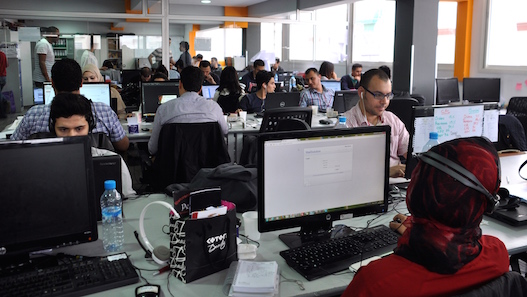Inside Jumia Maroc, a well-oiled machine


It may be an ordinary building in the residential neighborhood of Socrate in Casablanca, but the discrete design doesn’t lie, we’re standing in front of the offices of some of Morocco’s Web giants. Second floor: Kaymu, Lamudi, and Hellofood; third floor, Jumia.
More than 110 people work in Jumia’s sun-bathed open-space. Small groups lead meetings in orange booths, while others share notes and feedback across a communal table. We’re far from the studious and quiet atmosphere of the Parisian offices of Rocket Internet Afrique, Jumia’s parent company.
“I like when people shout throughout the offices,” says Jumia Maroc’ General manager Bastien Moreau. Don’t expect to find meeting rooms here. Collaborators meet in open booths or sit in the big boss’ office when he’s not here.
Still, this is only half of Jumia’s staff. More than 90 others work in the warehouse as couriers and stock administrators.
Wamda spent a Friday afternoon in the offices and warehouse of Jumia to see how this well-oiled company works, and what happens behind the scenes of a successful ecommerce website.
Inside the purchasing department
Here, a team of buyers selects products that match the tastes of Moroccan consumers. With the help of the Parisian group’s purchasing organization, Jumia’s team of buyers purchases international products such as fashion items, and trawl the Moroccan market for local products to buy.

Jumia’s website lists some 40,000 items. A group of 15 employees writes product descriptions and creates photos of items that Jumia offers.
The most frequently ordered items are stored in Jumia’s warehouse, an hour away from Casablanca, while less popular items remain in suppliers’ warehouses. When an order is received, a courier is dispatched to bring the item to the warehouse from where it is sent to the client.
A team of jolly marketers
Everybody on the marketing crew plays a specific role. One is in charge of newsletters, another of Facebook ads, a third of social media content. One person responds to clients on social media, and another is in charge of SEO. They all coordinate with the Parisian team, which keeps them up-to-date on sound marketing practices.

But there is more. Two employees work on offline marketing, like event organization and offline ads.
Client experience is such a priority at Jumia that they have one full-time collaborator tasked with ensuring that each department works together to create the best possible experience for all.
Customer service, the face of Jumia
The face of this client experience is the customer service department, whose 40 employees and six managers keep it operating from 8.30am to 10pm weekdays, and 9am to 6pm on weekends.

The team answers clients’ questions, leads satisfaction survey, and handles credit requests with the help of their bank partner Wafasalaf. Several team members are dedicated to VIPs, big clients that represent 15 percent of Jumia’s orders. And one person responds to as many as 10 online chat conversations at the same time.
The challenge of delivery
“We’re building our own DHL,” Moreau told Wamda. “This enables us to control the purchasing experience from A to Z to ensure than one someone buys one, they comes back for more.”

“The delivery crew knows shipping conditions; they know that clients can try on three pairs of shoes, and only accept part of the delivery,” he continues. “We’d rather reimburse a client, rather than have him dissatisfied with his experience.”
Shipping is free on all orders bove 300 Moroccan dirhams, (roughly $30 USD). “It’s costly, and not really optimal, but it’s like COD [cash-on-delivery]: it’s necessary to create trust and credibility.”
In the warehouse
Two shifts work together to ensure the warehouse is open from 9am to midnight. They have one objective: all orders must be ready for shipping in less than one hour.

The receiving team first inspects all incoming products.
The products in good condition are then given a bar code with a unique ID that helps the team track it at every stage in the warehouse.
The inventory crew then puts each product in its specific area in the warehouse to make retrieval as fast as possible when an order is received.
The photo studio
One corner of the warehouse is a creative mess - it’s the photo studio.
“It’s out of question that a product gets on the website without stopping by the photo studio,” says Iliasse Barka, production manager. “We can’t lose time. We have between 5 and 10 minutes to take a picture and put it online.”

The group has several models they can count on when they need photos of clothing items.
We got an order!
When an order is received, the delivery team prints the information to pass it along to the inventory crew which will retrieve the product.

Orders are then dispatched to the country’s major city where Jumia has a hub. There, packages are sent to their recipients by couriers.
While Jumia has many satisfied customers, some orders do come back to the warehouse. In some cases clients decide to return orders. And in other cases orders cannot be delivered. No matter. The team is working on to the next order…
You might also want to read:


